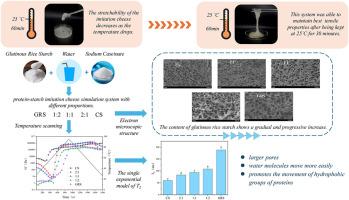Exploration of the stretchability of imitation cheese at room temperature II: the influence of the casein-glutinous rice starch ratio on the interaction mechanism among protein, starch, and moisture
IF 11
1区 农林科学
Q1 CHEMISTRY, APPLIED
引用次数: 0
Abstract
Cheese stretchability diminishes at room temperature, compromising its application properties. In this study, imitation cheese simulation systems were prepared with different proportions of sodium caseinate, glutinous rice starch, and moisture. By measuring the stretchability, microstructure, rheological properties, and other physical characteristics of the mixed system at different ratios, this study aimed to understand the impact of different sodium caseinate-glutinous rice starch ratios on the interaction mechanism in the imitation cheese system. It also explored the interaction mechanism between sodium caseinate, starch, and moisture within the system, providing a mechanistic explanation for improving the stretchability of cheese products at room temperature. The results showed that the greater the amount of glutinous rice starch added, the more stable the energy storage modulus (G′) was, and it also promoted the exposure of protein hydrophobic groups. Meanwhile, reducing the sodium caseinate content led to an increase in the moisture-to-protein ratio in the system, which lessened the restraint on hydrogen protons, making the moisture more free and thus more fluid. This was beneficial for enhancing the stretchability of the system at room temperature. As a result, the system with a mass ratio of sodium caseinate to glutinous rice starch of 1:1 could still maintain good strength properties after being placed at room temperature for 30 min.

仿干酪室温拉伸性能的探索II:酪蛋白-糯米淀粉比对蛋白质、淀粉和水分相互作用机理的影响
奶酪的拉伸性在室温下降低,影响其应用性能。本研究采用酪蛋白酸钠、糯米淀粉和水分的不同配比制备了仿奶酪仿真体系。本研究通过测定不同配比下混合体系的拉伸性、微观结构、流变性能等物理特性,了解不同比例酪蛋白钠-糯米淀粉对仿奶酪体系中相互作用机理的影响。探讨了酪蛋白酸钠与淀粉、水分在体系内的相互作用机理,为提高常温下奶酪制品的拉伸性提供了机理解释。结果表明,糯米淀粉添加量越大,其储能模量(G′)越稳定,并促进了蛋白质疏水性基团的暴露。同时,酪蛋白酸钠含量的降低导致体系中水分与蛋白质的比例增加,从而减少了对氢质子的约束,使水分更加自由,从而更具流动性。这有利于提高体系在室温下的拉伸性能。结果表明,酪蛋白酸钠与糯米淀粉质量比为1:1的体系在室温下放置30 min后仍能保持良好的强度性能。
本文章由计算机程序翻译,如有差异,请以英文原文为准。
求助全文
约1分钟内获得全文
求助全文
来源期刊

Food Hydrocolloids
工程技术-食品科技
CiteScore
19.90
自引率
14.00%
发文量
871
审稿时长
37 days
期刊介绍:
Food Hydrocolloids publishes original and innovative research focused on the characterization, functional properties, and applications of hydrocolloid materials used in food products. These hydrocolloids, defined as polysaccharides and proteins of commercial importance, are added to control aspects such as texture, stability, rheology, and sensory properties. The research's primary emphasis should be on the hydrocolloids themselves, with thorough descriptions of their source, nature, and physicochemical characteristics. Manuscripts are expected to clearly outline specific aims and objectives, include a fundamental discussion of research findings at the molecular level, and address the significance of the results. Studies on hydrocolloids in complex formulations should concentrate on their overall properties and mechanisms of action, while simple formulation development studies may not be considered for publication.
The main areas of interest are:
-Chemical and physicochemical characterisation
Thermal properties including glass transitions and conformational changes-
Rheological properties including viscosity, viscoelastic properties and gelation behaviour-
The influence on organoleptic properties-
Interfacial properties including stabilisation of dispersions, emulsions and foams-
Film forming properties with application to edible films and active packaging-
Encapsulation and controlled release of active compounds-
The influence on health including their role as dietary fibre-
Manipulation of hydrocolloid structure and functionality through chemical, biochemical and physical processes-
New hydrocolloids and hydrocolloid sources of commercial potential.
The Journal also publishes Review articles that provide an overview of the latest developments in topics of specific interest to researchers in this field of activity.
 求助内容:
求助内容: 应助结果提醒方式:
应助结果提醒方式:


